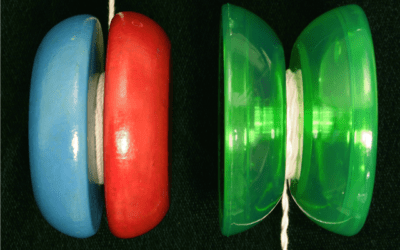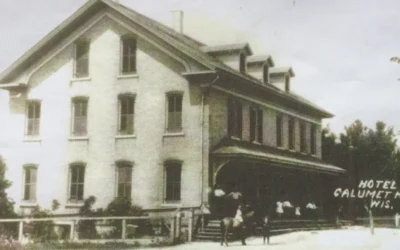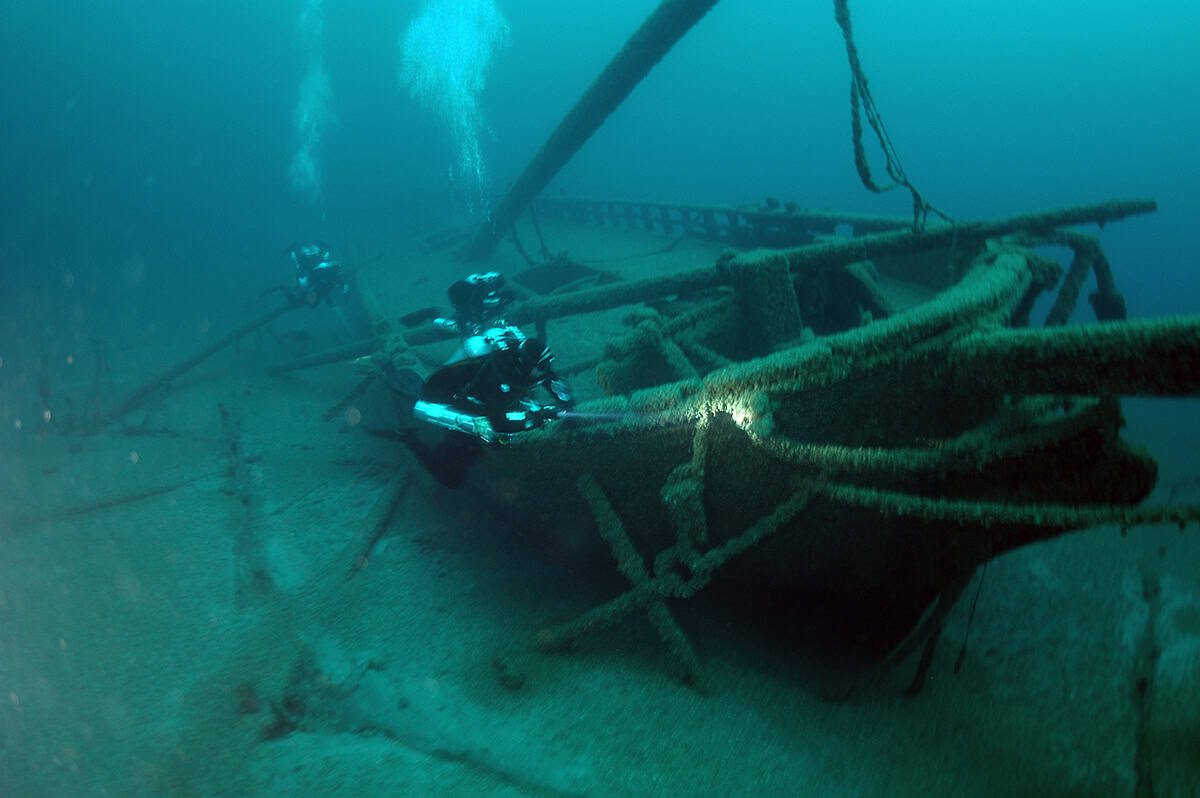
Divers swim up toward the bow of the Gallinipper. (Photo by Tamara Thomsen)
A maritime archeologist shares the stories of six surprising shipwrecks in Wisconsin’s Great Lakes, from historic vessels to unusual cargo.
Did you know there are more than 700 known shipwrecks in the Wisconsin Great Lakes? And while some are beginning to disappear, many are remarkably well-preserved due to the fresh, frigid lake waters. Every year, people from all over the country and the world come to visit and scuba dive these wrecks. Some are infamous, like the Rouse Simmons, also known as the Christmas Tree Ship, while others are just as interesting but lesser known.
In order to rediscover some of these wrecks, we talked to Tamara Thomsen, a maritime archaeologist for the Wisconsin Historical Society. With more than 20 years of experience, she has encountered dozens of shipwrecks while working as a photographer, researcher, and research diver. To help us learn more about Wisconsin’s maritime history, she shared the stories of some of the shipwrecks she finds most fascinating.

1. Gallinipper
Built: 1833
Sank: 1851
Discovered: 1994
Depth (feet): 210
Nearest City: Cleveland, WI
The Gallinipper is Wisconsin’s oldest known shipwreck. With ties to the fur trade, the ship was originally commissioned by Michael Dousman in 1832 and named the Nancy Dousman. The Dousmans were a very prominent family in the early Wisconsin frontier. There is even a town in Waukesha County named after one of its members.
In 1846, the ship went through a major transformation, which increased its cargo capacity but would eventually lead to its downfall. According to Thomsen, the alteration caused the ship to turn turtle or capsize multiple times. In 1851, the ship capsized yet again during a storm, but this time it became waterlogged and sank. Luckily, the crew, captain, and passengers were rescued by the schooner Cleopatra, which was passing nearby.
Today, the ship rests in about 210 feet of water and is largely intact and upright. The ship sank near what is now Cleveland, WI, in Manitowoc County on its way to Michigan with a load of lumber. The remains of the ship are a part of the Wisconsin Shipwreck Coast National Marine Sanctuary.
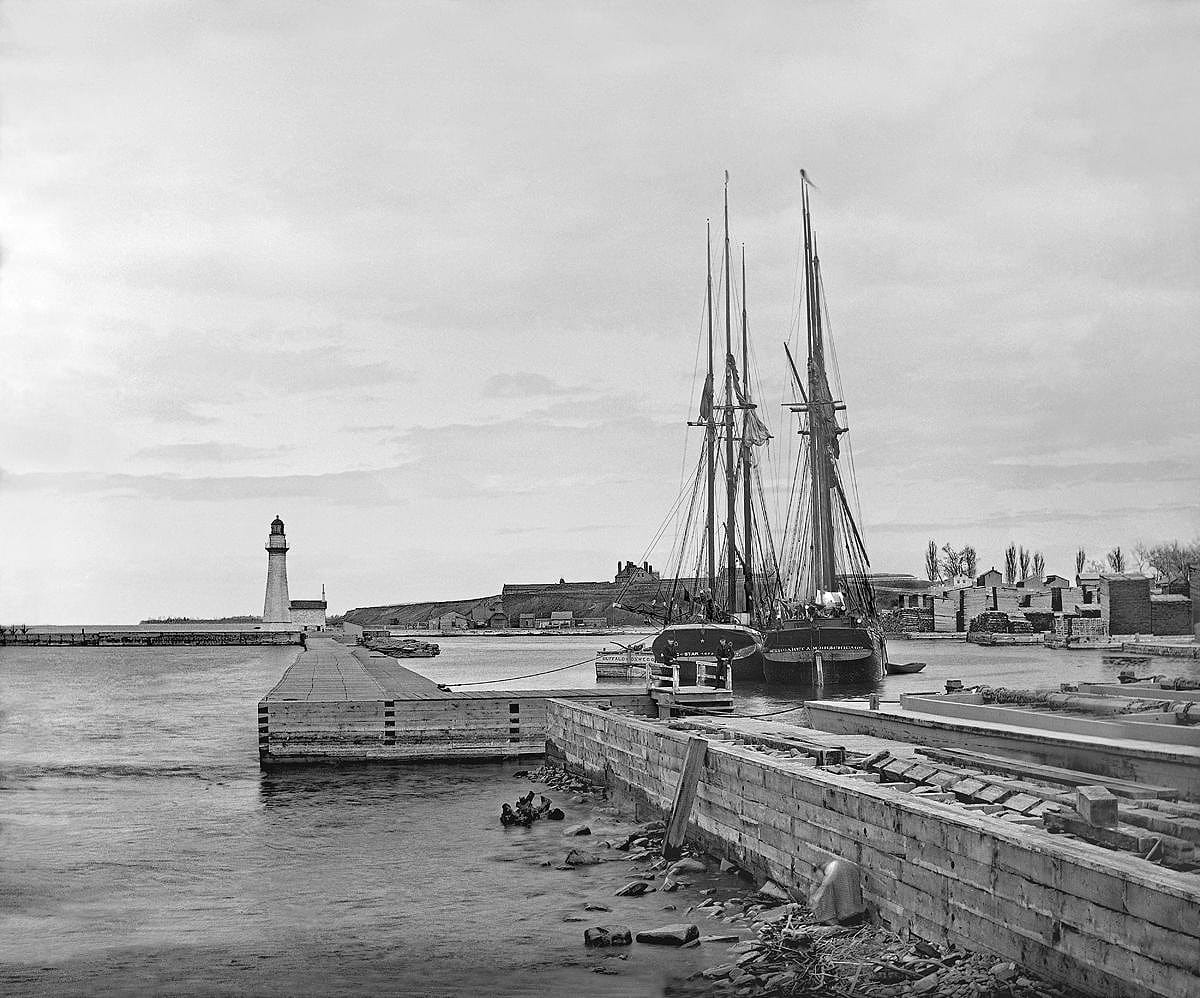
2. Margaret A. Muir
Built: 1872
Sank: 1893
Discovered: 2024
Depth (feet): 50
Nearest City: Ahnapee, WI
The Margaret A. Muir was lost while carrying a load of salt near Algoma in 1893. Throughout its service, the ship ran into several issues, including multiple collisions and leaks. During its final voyage, it encountered a storm where large amounts of water crashed onto the deck, essentially engulfing the ship. The captain and crew narrowly escaped on lifeboats. A later report from Captain David Clow describes the perilous journey to safety.
“We didn’t lose a minute’s time and had just gotten into our lifeboat when the schooner keeled over and filled our lifeboat with water. Fortunately, it was not capsized at all, and we succeeded in bailing it out. We were four miles out from shore and had several narrow escapes from drowning on the way in. In getting through the breakers, it seemed as if every man must be drowned, but luck was with us and we all got on the beach safely…” While all the people on the ship did make it to safety, the captain’s Newfoundland dog went down with the vessel.
The ship rested just outside the entrance to the harbor in Algoma for more than a hundred years before being rediscovered by maritime historians Brendon Baillod, Bob Jaeck, and Kevin Cullen in May of 2024. “It’s baffling to me,” says Thomsen. “I mean, [the ship] is immediately out of the harbor entrance… and on a weekend there’s 50 if not 100 boats going out of there to go fishing. This is the fishing grounds. This is where people go,” she continues. “They ran over that boat for that many years and didn’t notice it was a shipwreck.”
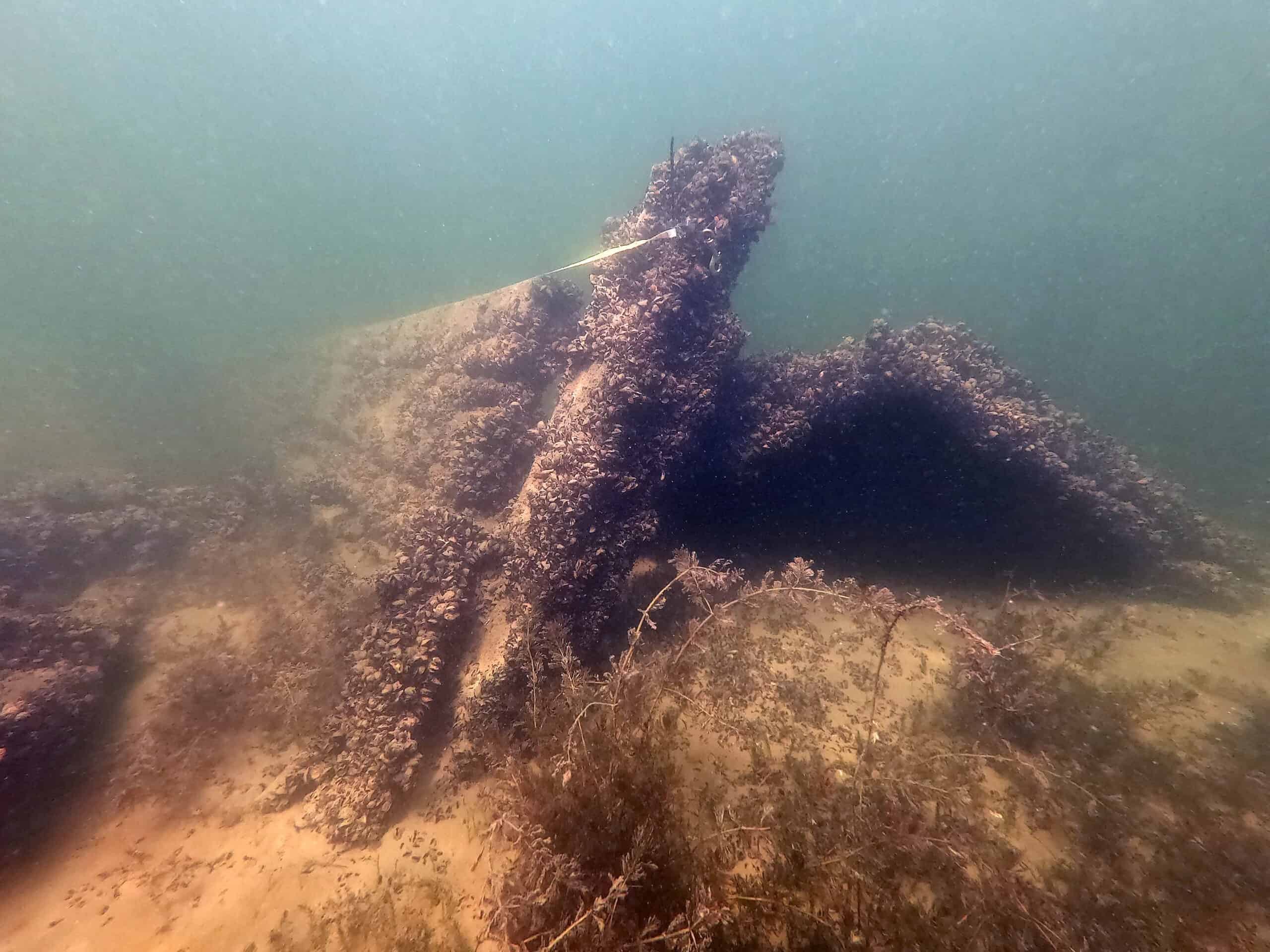
3. Pride
Built: 1866
Sank: 1898
Discovered: NA
Depth (feet): 12
Nearest City: Sturgeon Bay, WI
Pride was originally built in 1866 in Ohio and changed hands multiple times throughout its years of service before being purchased by Captain Jacob Wilson in 1893. Captain Wilson used the ship to haul cargo such as lumber and was accompanied by his son and the ship’s mate, Thomas Wilson. During a routine trip to Egg Harbor in 1898, the pair was caught in a storm, and the ship was struck by a tornado. Pride flipped over so violently that its two masts became embedded in the lake bottom. Captain Wilson survived and was later rescued by a local fisherman. His son, unfortunately, lost his life in the storm.
A couple of days after the incident, the ship was righted and thoroughly searched. Miraculously, inside the cabin was Hobson, the Wilson’s Newfoundland, who was hungry but otherwise unharmed.
Following the disaster, the ship was brought to a “marine cemetery,” though it eventually fell apart and sank in 1901. Today, the ship is located in Sturgeon Bay in a mere 12 feet of water.

4. Milwaukee Car Ferry
Built: 1903
Sank: 1929
Discovered: 1972
Depth (feet): 125
Nearest City: Milwaukee, WI
While many shipwrecks in Wisconsin carried standard cargo, such as grain or lumber, there were a few that transported more unique products, which you can still see preserved today. One such ship is the Milwaukee. This car ferry tragically sank in October of 1929 after heading into one of Lake Michigan’s worst recorded storms. Since there were no survivors, it is impossible to know exactly what happened that day.
However, according to Thomsen, one thing we do know is that the ship sank with two rail cars full of Kohler bathtubs and fixtures. The bathtubs are now 125 feet below the surface, remarkably preserved, and resting in the same place they were loaded nearly 100 years ago.

5. Senator
Built: 1896
Sank: 1929
Discovered: 2015
Depth (feet): 415
Nearest City: Port Washington
The Senator is another ship that sank with interesting cargo on board. Coincidentally, its final voyage was only a few days after the Milwaukee’s. The Senator sank on October 31, 1929, after a collision with another ship during a trip from Milwaukee to Detroit. Seven men tragically drowned during the accident.
The ship’s cargo included 268 Nash automobiles, which are considered the largest known unmodified collection of early Wisconsin-built automobiles. The cars remain with the ship in 415 feet of water, 16 miles northeast of Port Washington. While the automobiles that were loaded onto the deck have since slid off, those loaded in the hull are eerily chained in place exactly as they were almost 100 years ago.
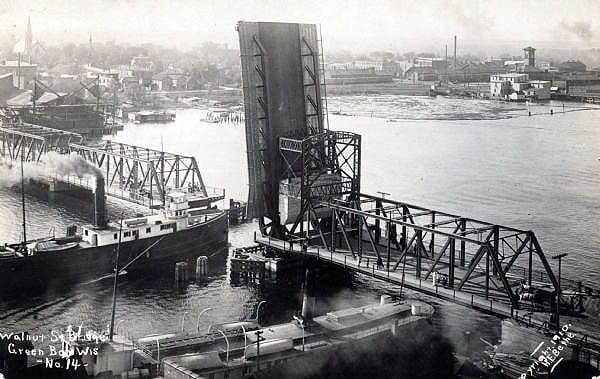
6. J.C. Aimes
Built: 1881
Sank: 1923
Discovered: 2025
Depth (feet): 9
Nearest City: Manitowoc
After a long career as one of the largest and most powerful tugboats ever built on the Great Lakes, the J.C. Ames was retired and dismantled in 1923. After all its engines, boilers, and things of value were removed, the hull was towed to Maritime Bay outside of Manitowoc. The ship was then subsequently set on fire for the amusement and entertainment of spectators before it sank in 9 feet of water.
The J.C. Ames is just one of at least 13 known ships to have been disposed of this way by Captain West, the owner of a local shipbuilding company. “He would have big parties for the town, and they would take these derelict vessels out in front of his property and blow them up and set them ablaze and watch them burn down. The town could come out and stand along the shores and watch this happen,” says Thomsen.
After sinking, the J.C. Ames and West’s other ships were largely forgotten about until relatively recently. The J.C. Ames, for example, was rediscovered in May 2025, when a young local fisherman found it while out fishing.
Because the ship rests in such shallow water, it’s possible to see it and the other abandoned ships while kayaking or paddleboarding in the area.
Want to learn more?
While we’ve covered six interesting wrecks, there are hundreds more to discover. Some are still lost, while others you can visit and even snorkel over. To learn more about Wisconsin shipwrecks, visit wisconsinshipwrecks.org. There, you can find a map with confirmed and unconfirmed wreck sites, along with the history of each ship.
If you are looking to visit the wrecks, Thomsen recommends checking out the Wisconsin Lake Michigan and Lake Superior State Water Trails. This resource, run by the Wisconsin DNR, features an interactive map where you can filter for shallow shipwrecks. Many of these are visible while kayaking, paddleboarding, or snorkeling. That being said, if you decide to visit one of these wrecks, make sure to exercise proper caution and take necessary safety measures.

A timeline of the storied history behind Wisconsin’s former Badger Army Ammunition Plant
The land which once held a massive munitions plant near Devil's Lake State Park has had many chapters. From the prairie home of the Ho-Chunk Nation,...

5 unsung films that dramatize America’s rich labor history
By Peter Dreier, Occidental College The U.S. is in the midst of a new upsurge of union organizing. Is a Hollywood drama about angry Starbucks...

13 famous people who are buried in Wisconsin
From famous architects to movie stars and rock ‘n’ roll legends, there are plenty of famous graves to pay your respects at in Wisconsin. Choosing...

Forward, Not Backward: 4 historic steps Wisconsin took first
Our state motto is FORWARD, not BACKWARD 💙 And despite Republicans’ best efforts, at times, to stand in the way, Wisconsin has become one of...



